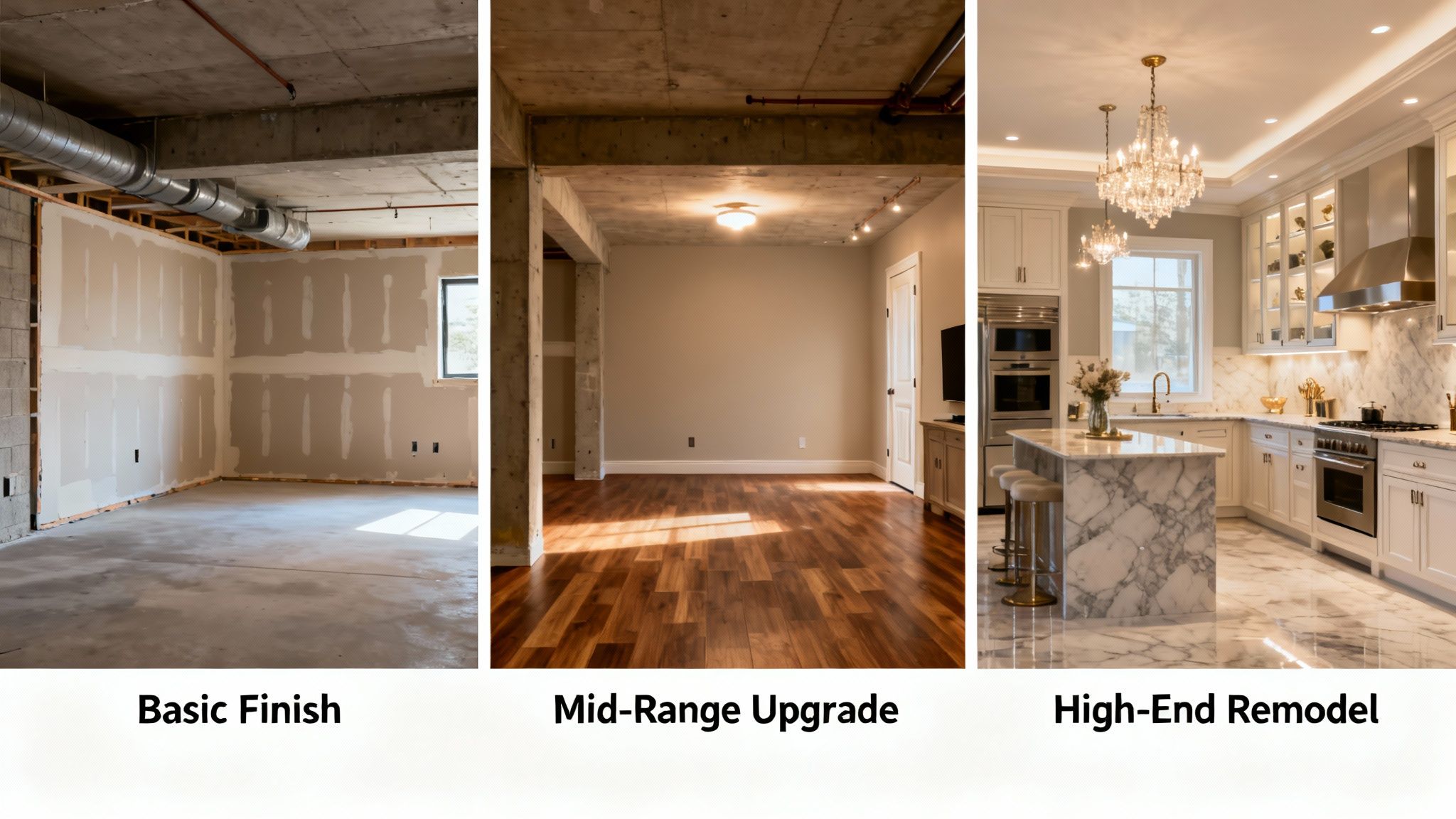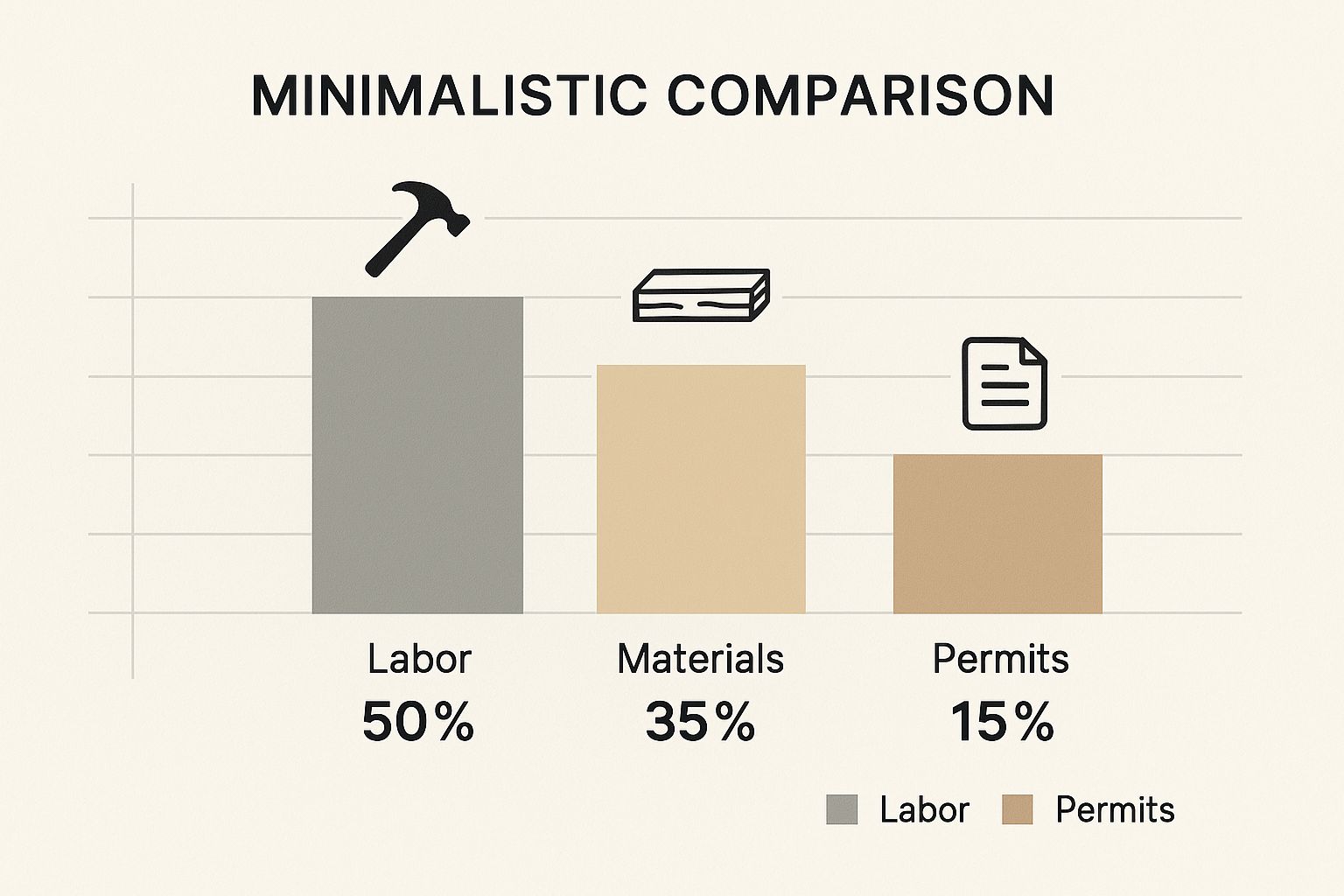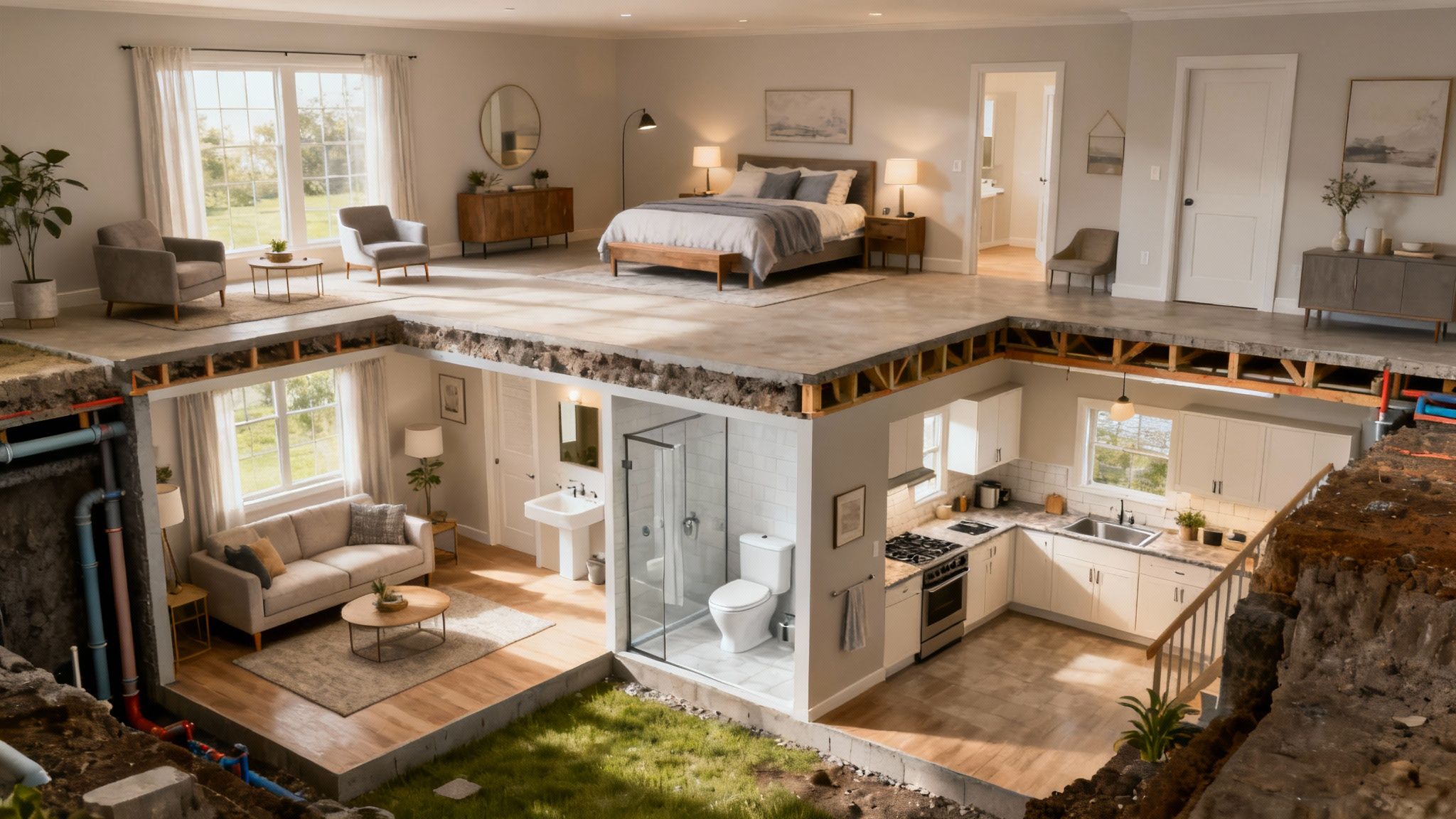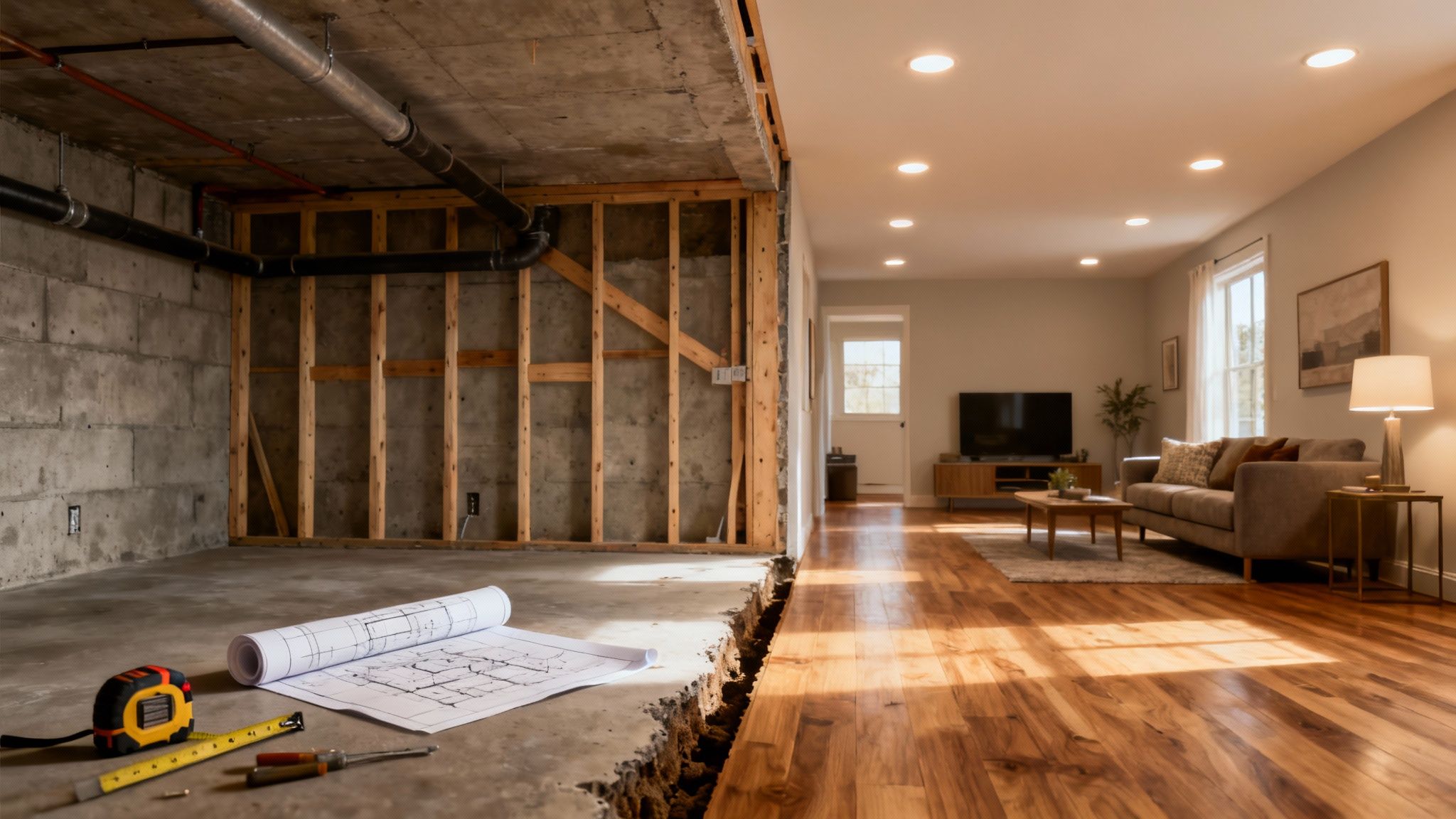How Much Does a Basement Renovation Cost? Your Complete Guide
So, you're thinking about tackling that basement renovation. It's one of the best ways to unlock a ton of usable square footage in your home, but the big question is always the same: what's it going to cost?
The truth is, there’s no single price tag. For a typical 1,000-square-foot basement, you can expect to spend anywhere from $7,000 to $23,000 on average. That's a pretty wide range, and the final number really comes down to what you're trying to achieve—are you simply finishing a blank canvas, or are you gutting an old, dated space for a full remodel?
Your Basement Renovation Cost: The Quick Answer

Before we get into the nitty-gritty, let's establish a clear financial baseline. I always tell my clients to think of it as a spectrum. On one end, you have a straightforward, basic finish. On the other, a high-end, custom remodel. Every choice you make—from the type of flooring to adding a bathroom—will move you along that spectrum.
Nationally, the going rate for finishing a 1,000 sq ft basement falls between $7 and $23 per square foot. The more complex the job and the fancier the materials, the higher you'll climb on that scale. This is a great starting point for understanding how these projects are priced across the country.
To give you a better feel for where your project might land, I've put together a table breaking down the typical costs. Think of this as a bird's-eye view before we dive into all the details that can push these numbers up or down.
Average Basement Renovation Costs At a Glance (1,000 sq ft)
| Basic Finish | $7,000 – $15,000 | $7 – $15 |
| Mid-Range Remodel | $15,000 – $35,000 | $15 – $35 |
| High-End Remodel | $35,000 – $75,000+ | $35 – $75+ |
Want to dial in a more precise budget? For a more tailored look at what your specific project might cost, using a detailed basement finishing cost calculator can give you a much sharper estimate.
So what do these levels actually mean for your space?
- A basic finish is all about creating a clean, functional room. We're talking framing, drywall, basic electrical and lighting, and budget-friendly flooring. It's the perfect route for a simple playroom or a tidy storage area.
- Stepping up to a mid-range remodel brings in more creature comforts. This is where you might add a bathroom, install better lighting like recessed cans, put in some built-in shelving, and upgrade to nicer flooring like luxury vinyl plank. This is the sweet spot for creating a great family room or a comfortable guest suite.
- A high-end remodel is where you pull out all the stops. Think a dedicated home theater, a custom wet bar or kitchenette, an egress window to create a legal bedroom, and premium finishes from top to bottom. This is how you create a true showstopper space.
Deconstructing Your Renovation Budget
Thinking about how much a basement renovation costs can feel a bit like staring up at a mountain. It’s intimidating. But once you break the project down into its core components, it all becomes much more manageable. Think of your total budget as a pie sliced into three main pieces: labor, materials, and permits.
These aren't just random line items on a contractor's quote; they're the foundational pillars of your entire renovation. Getting a firm grip on what each one entails is the first real step toward building a budget that works for you, not against you.
The Big Three Cost Components
Every single dollar you pour into your basement project will fall into one of those three buckets. Generally, labor is the biggest slice of the pie—skilled trades are essential for a safe, high-quality job. Materials are next, and this is where you have the most control to save or splurge. Lastly, permits are a smaller but absolutely non-negotiable cost.
So, where does the money actually go? Here’s a pretty standard breakdown you can expect for a typical basement project.

As you can see, about half of your total spend will likely go directly to paying the pros. This really underscores how important it is to choose the right contractor.
Diving Into Material Costs
Materials are where your vision starts to take shape, but they're also the biggest wildcard in your budget. It’s a bit like buying a car. You can get a reliable, no-frills model that gets you from A to B, or you can opt for a luxury SUV loaded with every feature imaginable. Both work, but the price tags are worlds apart.
The same idea applies to finishing your basement. For instance:
- Flooring: You could go with a budget-friendly luxury vinyl plank (LVP), which is tough, waterproof, and looks fantastic. Or, you could install premium hardwood or custom tile, which will drive your costs way up.
- Lighting: A set of simple, contractor-grade recessed lights will do the job economically. On the other hand, if you're dreaming of a high-end home theater with custom fixtures and smart controls, that alone can cost thousands.
- Drywall: This is a fundamental building block. While the sheets of drywall are relatively cheap, the real cost is in the labor to hang it, tape it, mud it, and sand it to a smooth finish. For a deep dive into just this piece of the puzzle, check out this guide on the cost of drywalling a basement.
Key Takeaway: Your material choices have the single biggest impact on your ability to control the budget. Opting for mid-range finishes is one of the most effective ways to manage expenses without sacrificing quality or style.
Factoring in Labor and Permits
Get ready for the biggest number on your quote: labor. It typically accounts for a whopping 50-60% of the total project price. This chunk of cash pays for the expertise of your framers, electricians, plumbers, and drywall pros. It can be tempting to try and shave costs here, but hiring qualified, licensed professionals is non-negotiable for safety, quality, and your peace of mind.
Permits are another must-have. These are fees you pay to your local city or county to ensure your project is built to code. They cover critical safety standards for things like fire egress, electrical wiring, and ventilation. Skipping this step is a huge mistake that can result in fines, tear-out orders, and massive headaches when you eventually try to sell your home.
As you map out your budget, always be on the lookout for potential hidden costs. If your house was built before the 1980s, for example, you need to understand what homeowners need to know about asbestos in older homes, as finding and removing it can add an unexpected and significant expense.
How Your Vision Shapes The Final Price Tag

When it comes to figuring out how much a basement renovation costs, the single biggest factor isn't the size of the space—it's the size of your dream for it. What you plan to do with all that newfound square footage will dictate everything from the complexity of the plumbing to the specific permits you’ll need to pull.
To really make this click, let's walk through three common project scenarios. Think of them as different paths you can take, each with its own map of expenses and requirements. Seeing how the budget shifts from one to the next is the best way to align your vision with your wallet.
Scenario 1: The Open-Concept Family Room
This is the most straightforward and budget-friendly path. The goal here is simple: create a large, versatile space for movie nights, games, or a dedicated kids' play area. You’re essentially putting up the four walls of a finished room without the complex, and expensive, systems.
For this kind of project, your main costs will be:
- Framing and Drywall: Building out the perimeter and any simple interior walls.
- Basic Electrical: This means installing outlets and simple overhead lighting, like recessed cans.
- Flooring: Cost-effective options like luxury vinyl plank (LVP) or carpet are perfect for this.
- Painting: A relatively low-cost finishing touch that delivers a huge impact.
In this scenario, you completely sidestep the two biggest budget-busters in any basement project: plumbing and egress requirements. It's a fantastic way to add a ton of functional living space without a massive financial hit.
A simple, open-plan rec room is your entry point to a finished basement. By keeping the layout uncomplicated and avoiding plumbing, you can add significant usable square footage to your home at the lowest possible cost.
Scenario 2: Adding a Bedroom and Bathroom
Alright, let's raise the stakes. Say you want to create a private guest suite or a new bedroom for a growing family. This immediately introduces two major cost drivers that were totally absent in our first scenario: plumbing and egress.
Adding a bathroom means a crew has to break up your concrete slab to run new drain lines for a toilet, sink, and shower. This is tough, labor-intensive work that sends plumbing costs way up. You'll also need to budget for ventilation fans and waterproof materials.
Even more, for a room to be considered a legal, safe bedroom, it must have an egress window. This isn't just cutting a hole; it involves sawing through your foundation wall, installing a special, code-compliant window, and excavating an exterior window well for a safe escape route. This feature alone can add $5,000 to $10,000 to your project price.
Scenario 3: The Full In-Law Suite
Our final scenario is the most ambitious of all: a complete, self-contained apartment. This could be a new home for your in-laws or even a rental unit to generate extra income. This project takes everything from the previous scenarios—framing, electrical, plumbing, and an egress window—and adds a whole new layer of complexity.
Here’s what makes this the priciest option by far:
- A Kitchenette or Full Kitchen: This requires dedicated 220-volt wiring for appliances, more extensive plumbing for a sink and dishwasher, and, of course, cabinetry.
- A Separate Entrance: Often a must-have for privacy or rental purposes, adding an exterior door involves major foundation work.
- Stricter Building Codes: Municipalities often have much more stringent code requirements for rental units, covering things like fire separation between floors, soundproofing, and ventilation.
This level of renovation truly transforms your basement into a separate, fully functional living space. While the investment is significant, it also offers the highest potential return, whether you're collecting rent checks or just enjoying a massive boost in your property value.
Cost Comparison by Basement Renovation Project Type
To see this all laid out, let's compare how the costs for these different visions stack up. This table shows how adding key features dramatically impacts the overall budget.
| Basic Framing & Drywall | Baseline Cost | Baseline Cost | Baseline Cost |
| Standard Electrical | Low | Medium | High (for kitchen) |
| Flooring & Paint | Low | Medium | High (premium finishes) |
| Plumbing | None | High | Very High (kitchen + bath) |
| Egress Window | Not Required | Required (+$5k - $10k) | Required (+$5k - $10k) |
| Kitchen/Kitchenette | None | None | Very High (appliances, etc.) |
| Separate Entrance | Not Required | Optional (adds cost) | Often Required (adds cost) |
| Permits & Inspections | Low Complexity | Medium Complexity | High Complexity |
As you can see, the path from a simple open room to a full-blown apartment is paved with significant cost additions. Understanding where these jumps in price come from is the key to planning a project that meets both your needs and your budget.
Why Your Location Matters for Renovation Costs

It’s easy to look up national averages for a basement renovation, but that number is often just a fantasy. Your project isn't happening in a vacuum; it’s happening on your street, in your city.
Thinking you can apply a one-size-fits-all price is one of the biggest budgeting mistakes homeowners make. In reality, the exact same project could see its final cost swing by 30% or more just based on geography. Moving from a quiet suburb to a bustling downtown core can completely change the math.
So, what’s behind this? It all comes down to local economics. The cost of living in your area has a ripple effect, touching everything from what a plumber charges for an hour of their time to how much it costs to get a truckload of drywall delivered to your home.
Breaking Down the Geographic Cost Drivers
The single biggest variable is almost always local labor rates. A contractor trying to run a business in an expensive city like San Francisco or New York has sky-high overhead costs—from workshop rent to employee wages. That's a world away from a contractor in a small Midwestern town, and that difference gets baked right into your quote.
But it’s not just about labor. A few other key factors are at play:
- Material Transportation: Lumber, insulation, and fixtures don’t just magically appear. The further you are from a supplier or the more congested your city is, the more you'll pay in delivery fees.
- Permit Fees: Every town and city has its own fee structure for building permits, and the differences can be staggering. A permit might cost a few hundred dollars in one municipality and well over a thousand in the next town over for the very same job.
- Regional Building Codes: Some places have tougher rules than others. If you live in an area prone to flooding, hurricanes, or earthquakes, you'll face stricter codes that often require more expensive materials and specialized installation methods, adding to your bottom line.
Key Insight: Think of your zip code as one of the biggest line items on your budget. Before you get too deep into planning, you have to research local cost benchmarks and get quotes from several local contractors. That's the only way to get a true picture of what things cost where you live.
A Tale of Two Countries: U.S. vs. Canadian Costs
You can see this principle in action by just looking across North America. While the work itself is similar, different economic realities create totally different pricing. In many suburban parts of the U.S., a solid mid-range basement remodel often lands somewhere between $75 and $150 per square foot.
Jump over to major Canadian cities, like those in the Toronto-Hamilton area, and the story changes. A basic 1,000-square-foot renovation might run between $45,000 and $55,000 CAD. Want to add a three-piece bathroom? That mid-range project will likely push the total to $70,000–$85,000 CAD. You can find a deeper dive into Canadian renovation costs on Newfore.com.
This just goes to show why asking how much a basement renovation costs always has the same first answer: it depends entirely on where you are.
Calculating Your Project's Return on Investment
It’s smart to think about your basement project as a financial investment, not just another home expense. This changes the question from "how much will this cost me?" to "what value will this add to my house?" The key to answering that is understanding its Return on Investment (ROI).
Simply put, ROI tells you how much of your initial spending you can expect to get back when it's time to sell.
A finished basement is one of the best ways to make your property more appealing and command a higher price. You're not just adding drywall and flooring; you're adding valuable, functional living space. For potential buyers, seeing a ready-to-go home office, a comfortable guest suite, or a sprawling family room is a huge plus, and that appeal almost always translates into a better valuation.
Understanding Your Potential ROI
You won't get back every single dollar you put in, but basement renovations perform incredibly well compared to other home projects. It's no surprise they're a top choice for homeowners looking to improve their space. In the U.S., the average ROI for a basement renovation hovers around a very healthy 70%. You can get more details on remodeling industry trends on advancedesignstudio.com.
So, what does that mean in real numbers? If you spend $50,000 on your project, you can realistically expect your home's value to jump by about $35,000. Thinking about it this way, the true "cost" of the project feels a lot more manageable.
How Project Type Influences Your Return
Of course, not all basement makeovers deliver the same ROI. What you decide to build down there plays a huge role in the financial return you'll see.
- Lifestyle-Focused Spaces: A custom home gym or a high-end home theater is fantastic for your personal enjoyment. They definitely make a home more attractive, but because they cater to very specific tastes, their ROI might be a bit lower.
- Income-Generating Suites: This is where you can see the biggest financial win. Building a legal rental unit with its own entrance and a small kitchen often provides the highest ROI. It generates immediate monthly income, which is a massive selling point for buyers and helps the project pay for itself over time.
A well-executed basement renovation doesn't just add square footage; it adds tangible value that makes your property more competitive. In a tough market, a finished basement can be the key feature that makes your home stand out from the rest.
At the end of the day, the best strategy is to find a balance between what you'll enjoy now and what will pay off later. For a deeper dive into how different projects stack up, check out our guide on calculating your home remodel return on investment. It’ll help you design a space you'll love living in and one that makes great financial sense.
A Smart Homeowner's Guide To Budgeting
Figuring out the potential cost of a basement renovation is one half of the puzzle. The other, more important half, is building a realistic budget that you can actually stick to. Think of your budget as the blueprint for your project's financial health—it’s your best defense against surprise costs and the infamous "scope creep" that can send a renovation off the rails.
The first rule of thumb? Never, ever take the first quote you get. Make it a goal to connect with at least three different reputable, local contractors. This isn't just a hunt for the cheapest price; it's about getting a feel for the going rate in your area and, just as importantly, finding a professional you can trust. A good quote is more than a number—it’s a detailed breakdown of labor, materials, and any necessary permit fees.
Protect Your Budget From Surprises
After you've gathered your estimates and picked your contractor, it's time for the most crucial step: building in a cushion. I've been on enough job sites to know that every single renovation hits a snag or two. You might open up a wall and find old, leaky pipes or discover the electrical wiring needs a complete overhaul. This is where a contingency fund saves the day.
The Contingency Fund Rule: Always set aside an extra 15-20% of the total estimated cost. So, if your project is quoted at $50,000, your actual working budget should be closer to $57,500. This isn't "extra" money for fancy upgrades; it's your emergency fund for the unexpected.
Finally, let's talk about saving some money without cutting corners on quality. There are almost always opportunities to trim the budget if you know where to look.
Here are a few strategies that consistently work for homeowners:
- DIY the Demolition and Painting: If you're willing to put in some sweat equity, handling the non-structural tear-out and painting the walls yourself can shave a nice chunk off your labor bill.
- Choose Mid-Range Finishes: You don't always need the most expensive option to get a high-end look. For example, modern luxury vinyl plank flooring looks fantastic and is incredibly durable, often saving you thousands compared to premium hardwood.
- Time Your Project Wisely: Contractors hit their busy season in the spring and summer. If you can schedule your renovation for the off-season, like late fall or winter, you might find they have more availability and potentially more competitive pricing.
Answering Your Top Basement Renovation Questions
Once you have a budget in mind, the real-world questions start popping up. Let's tackle some of the most common things homeowners ask before they dive into a basement project.
How Long Does a Typical Basement Renovation Take?
For a standard 1,000 sq ft basement, you should plan for a timeline of anywhere from 4 to 12 weeks. This window covers everything from the first swing of the sledgehammer to the final brushstroke of paint.
What pushes a project toward the longer end of that spectrum? Complexity. A simple, open-concept media room will be on the faster side. But if you’re adding a full bathroom or a kitchenette, the intricate plumbing, new wiring, and extra city inspections will naturally extend the schedule. Don't forget that your contractor's schedule and how quickly your local permitting office works are also major factors.
Do I Always Need a Permit for a Basement Renovation?
Almost always, yes. If your project involves changing the structure, running new electrical lines, or adding plumbing, a permit is not just a good idea—it's the law.
Think of a permit as your project's safety net. It ensures all the work meets crucial building codes for things like fire egress, ventilation, and electrical safety. Skipping this step can come back to haunt you with hefty fines, orders to tear out the work, or major headaches when it's time to sell your house.
What Is the Cheapest Way to Finish a Basement?
Keeping costs down is all about embracing simplicity and making savvy choices with your materials. An open-concept layout is a great start, as it requires less framing and drywall. For the ceiling, instead of a traditional drywall finish, you can get a cool, industrial vibe by simply painting the exposed joists and ductwork black for a fraction of the cost.
When it comes to flooring, luxury vinyl plank (LVP) is a fantastic budget-friendly option that's both waterproof and incredibly durable. And, of course, you can save a ton on labor by handling the final cosmetic touches, like painting, yourself. Taking the time to learn how to organize your basement beforehand can also help clarify what you truly need, preventing overspending on your renovation.
Ready to transform your basement without the stress? The team at Northpoint Construction specializes in creating beautiful, functional spaces that fit your vision and budget. Contact us today to get a clear, detailed estimate for your project.

